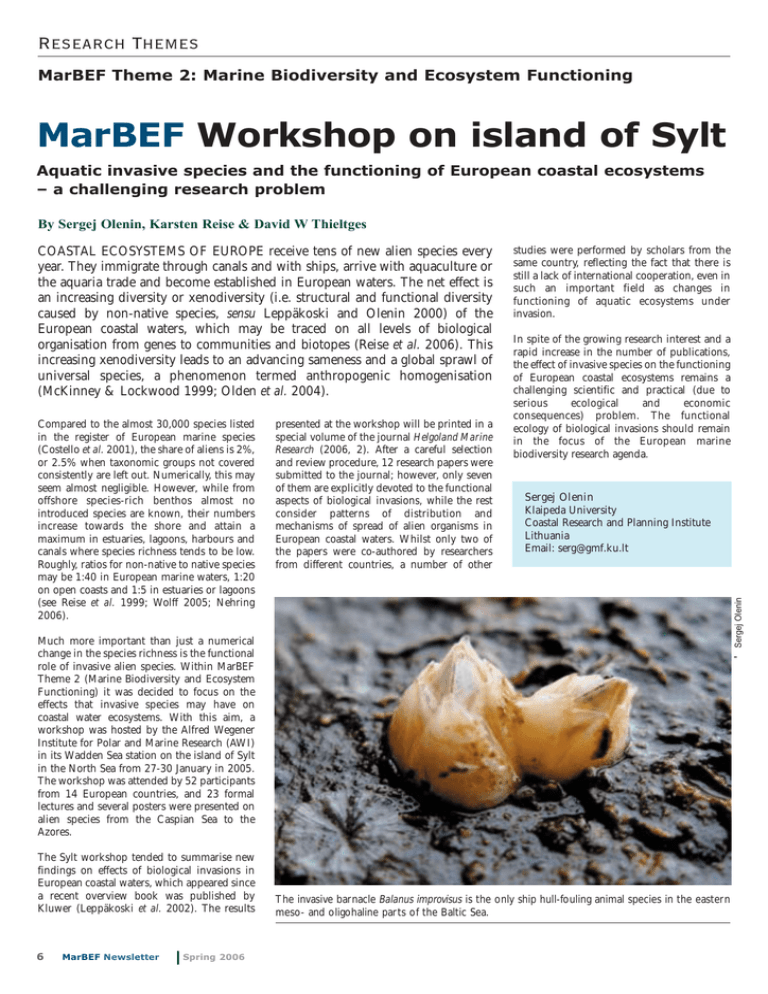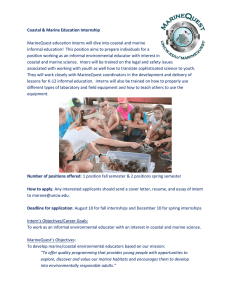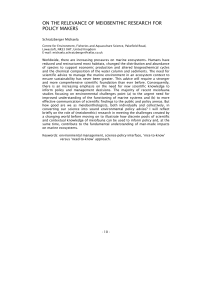MarBEF Workshop on island of Sylt Research Themes
advertisement

Research Themes MarBEF Theme 2: Marine Biodiversity and Ecosystem Functioning MarBEF Workshop on island of Sylt Aquatic invasive species and the functioning of European coastal ecosystems – a challenging research problem By Sergej Olenin, Karsten Reise & David W Thieltges COASTAL ECOSYSTEMS OF EUROPE receive tens of new alien species every year. They immigrate through canals and with ships, arrive with aquaculture or the aquaria trade and become established in European waters. The net effect is an increasing diversity or xenodiversity (i.e. structural and functional diversity caused by non-native species, sensu Leppäkoski and Olenin 2000) of the European coastal waters, which may be traced on all levels of biological organisation from genes to communities and biotopes (Reise et al. 2006). This increasing xenodiversity leads to an advancing sameness and a global sprawl of universal species, a phenomenon termed anthropogenic homogenisation (McKinney & Lockwood 1999; Olden et al. 2004). presented at the workshop will be printed in a special volume of the journal Helgoland Marine Research (2006, 2). After a careful selection and review procedure, 12 research papers were submitted to the journal; however, only seven of them are explicitly devoted to the functional aspects of biological invasions, while the rest consider patterns of distribution and mechanisms of spread of alien organisms in European coastal waters. Whilst only two of the papers were co-authored by researchers from different countries, a number of other In spite of the growing research interest and a rapid increase in the number of publications, the effect of invasive species on the functioning of European coastal ecosystems remains a challenging scientific and practical (due to serious ecological and economic consequences) problem. The functional ecology of biological invasions should remain in the focus of the European marine biodiversity research agenda. Sergej Olenin Klaipeda University Coastal Research and Planning Institute Lithuania Email: serg@gmf.ku.lt Sergej Olenin Compared to the almost 30,000 species listed in the register of European marine species (Costello et al. 2001), the share of aliens is 2%, or 2.5% when taxonomic groups not covered consistently are left out. Numerically, this may seem almost negligible. However, while from offshore species-rich benthos almost no introduced species are known, their numbers increase towards the shore and attain a maximum in estuaries, lagoons, harbours and canals where species richness tends to be low. Roughly, ratios for non-native to native species may be 1:40 in European marine waters, 1:20 on open coasts and 1:5 in estuaries or lagoons (see Reise et al. 1999; Wolff 2005; Nehring 2006). studies were performed by scholars from the same country, reflecting the fact that there is still a lack of international cooperation, even in such an important field as changes in functioning of aquatic ecosystems under invasion. The Sylt workshop tended to summarise new findings on effects of biological invasions in European coastal waters, which appeared since a recent overview book was published by Kluwer (Leppäkoski et al. 2002). The results 6 MarBEF Newsletter Spring 2006 ' Much more important than just a numerical change in the species richness is the functional role of invasive alien species. Within MarBEF Theme 2 (Marine Biodiversity and Ecosystem Functioning) it was decided to focus on the effects that invasive species may have on coastal water ecosystems. With this aim, a workshop was hosted by the Alfred Wegener Institute for Polar and Marine Research (AWI) in its Wadden Sea station on the island of Sylt in the North Sea from 27-30 January in 2005. The workshop was attended by 52 participants from 14 European countries, and 23 formal lectures and several posters were presented on alien species from the Caspian Sea to the Azores. The invasive barnacle Balanus improvisus is the only ship hull-fouling animal species in the eastern meso- and oligohaline parts of the Baltic Sea. Sergej Olenin The Sylt workshop on “Aquatic invasive species and the functioning of European coastal ecosystems” arrived at the following conclusions: ' Conclusions from Sylt • The global transport of marine and brackish-water organisms has caused an unprecedented increase in the number of species across European coastal seas. These introductions result in global mixing of previously isolated biotas and promote the dominance of universal species. • So far, there is no evidence of European-scale extinctions of native species caused by the biological invasions, while local extinctions are apparent. Introductions are noted more readily; however, proof of extinctions may take much longer. Strong shifts in ecosystem functioning have been documented already (e.g. the recent American comb jelly Mnemiopsis leidyi invasions into the Black and Caspian Seas). • Some invasive species (i.e. pathogens, toxic algae, fouling organisms) severely threaten the goods and services of European coastal ecosystems. On the other hand, introduced cultured marine organisms have attained high economic value. Introduced species have widened and intensified functional properties in European coastal ecosystems, achieving dominance and adding to food web and habitat complexity. Their effects are particularly strong in estuaries, coastal lagoons and isolated water bodies. The invasion success of introduced species in European seas is greatly facilitated by anthropogenic transformations, exploitations and disturbances of coastal ecosystems as well as by climate change. • The problem of biological invasions has now become the focus of a rapidly growing research area. Many indirect and cascading effects are still poorly understood, and mechanisms as well as long-term effects are largely unexplored. Interdisciplinary studies and an integrative approach on the effects of introduced species provide model systems for community interactions and may considerably improve our knowledge on biodiversity and ecosystem functioning. In order to elucidate mechanisms, evaluate effects and anticipate long-term consequences of species introductions into European coastal waters, it is necessary to proceed from national projects to a European-wide effort with a comparative approach. Once a species has been introduced, a further spread along European coasts is inevitable, and we need scenarios on expected spreading and impacts to provide a rationale for precautionary measures. • ' Sergej Olenin We recommend establishing European policies to minimise the risk of introductions of harmful species by precautionary measures based on sound research. We also recommend that existing protocols (i.e., ICES Code of Practice for the Introduction and Transfer of Marine Organisms, and IMO Ballast Water Management Convention) to avoid unwanted introductions should be followed. The Chinese mitten crab Eriocheir sinensis, a highly invasive species. The first introduction into European waters happened about one hundred years ago. References Costello, M.J., Emblow, C.S. & White, R. (eds) 2001. European Register of Marine Species. A check-list of the marine species in Europe and a bibliography of guides to their identification. Patrimoines naturels, 50. Leppäkoski, E. & Olenin, S. 2000. Xenodiversity of the European brackish water seas: the North American contribution. In: Proc. of the First National Conference on Marine Bioinvasions. J. Pederson (ed). Boston, USA, 2000: 107-119. Leppäkoski, E., Gollasch, S. & Olenin, S. (eds) 2002. Invasive aquatic species of Europe: distribution, impacts and management. Kluwer Academic Publ, Dordrecht. McKinney M.L. & Lockwood J.L. 1999. Biotic homogenization: a few winners replacing many losers in the next mass extinction. Trends in Ecology and Evolution 14:450-453. Nehring S. 2006. Four arguments why so many alien species settle into estuaries, with special reference to the German river Elbe. Helgol Mar Res 60, 2 (in press). Olden J.D. & Poff N.L. 2004. Clarifying biotic homogenization. Trends in Ecology and Evolution 19: 283-284. Reise, K., Olenin S. & Thieltges D.W. 2006. Are aliens threatening European aquatic coastal ecosystems? Helgol Mar Res 60, 2 (in press). Reise K., Gollasch S. & Wolff W.J. 1998. Introduced marine species of the North Sea coasts. Helgol Meeresuntersuchungen 52: 219234. Wolff W.J. 2005. Non-indigenous marine and estuarine species in The Netherlands. Zool Med Leiden 79:1-116. The tube-building polychaete Phycopomatus enigmaticus forms dense fouling on hard substrata including ship hulls. Spring 2006 MarBEF Newsletter 7







